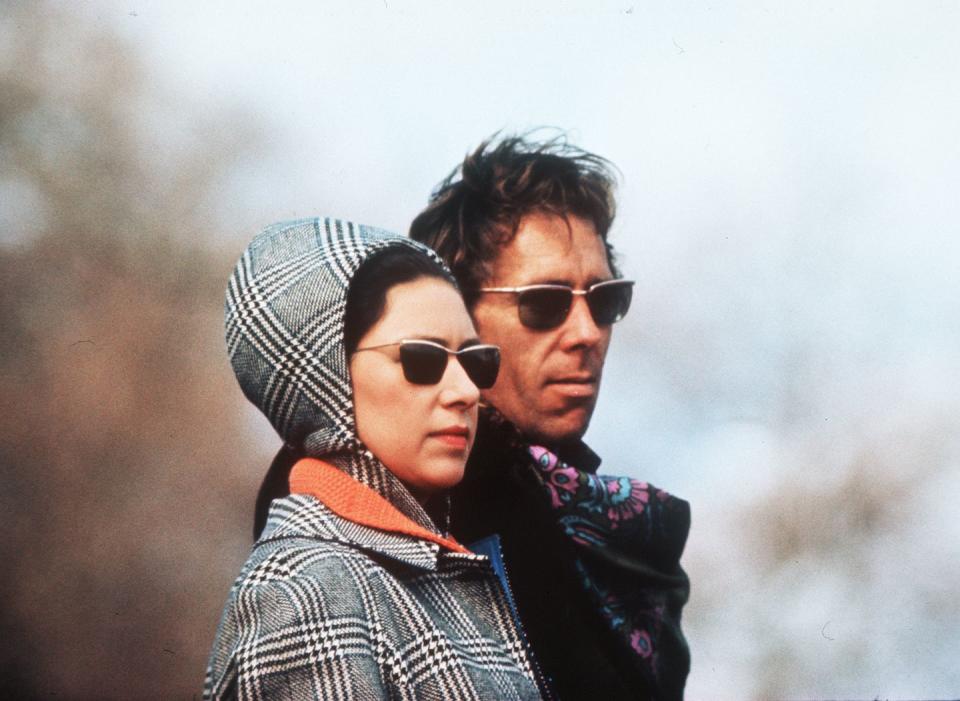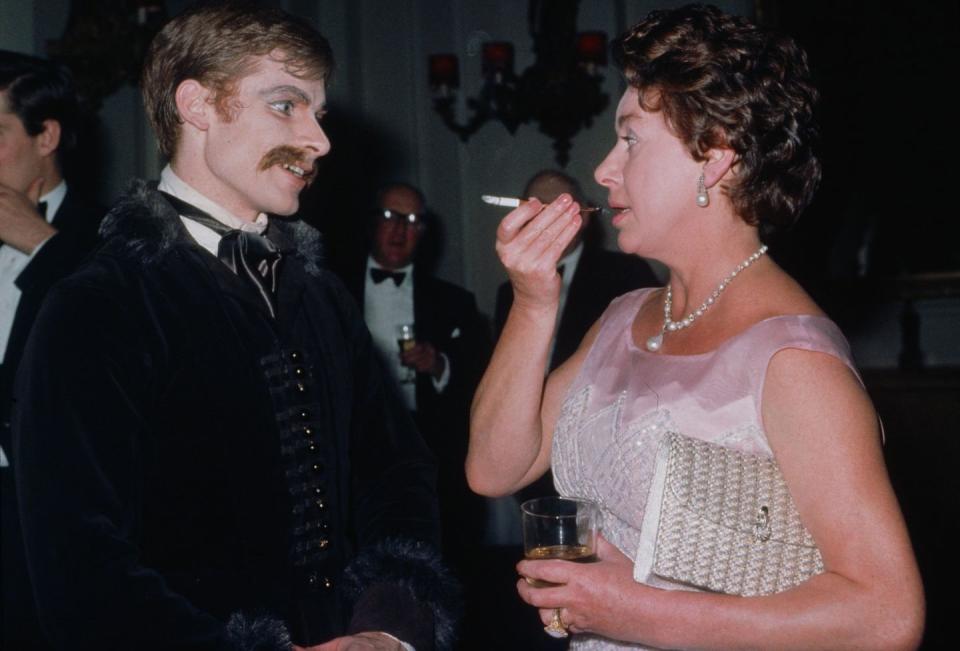Is Princess Margaret a Gay Icon?
- Oops!Something went wrong.Please try again later.
- Oops!Something went wrong.Please try again later.
In an otherwise serious season of The Crown, one of the more laughable moments comes in Episode 7, "The Hereditary Principle," when Queen Elizabeth explains to her sister Princess Margaret why her friend Derek Jennings couldn't possibly be in love with her. It's not just that he was entering the seminary to become a priest. Dazzle, or “Dehzehl," the queen tells Margaret, is a "Friend of Dorothy."
Jennings, an openly gay priest who existed in real life, wasn't the only unrequited love affair Margaret experienced, but his storyline this season, combined with Helena Bonham Carter's already glamorously world-weary and borderline campy depiction, brings Her Royal Highness ever closer to gay icon status. In real life, as it turns out, Margaret's relationship with gay men was more complicated than this season let on, often tricky but never quite so clueless.
“A lot of her friends no doubt were gay,” says Anne de Courcy, the biographer of Margaret's ex-husband, the late Lord Snowdon, who was reportedly bisexual. “She’d grown up around them.” In fact, there were so many gay men in the royal household, one apocryphal story goes, that the Queen Mother once rang her staff wondering about her gin and Dubonnet, “I don’t know about any of you queens down there, but this Queen up here wants a drink.”

Beyond her adolescent home life, Margaret spent much of her social life in the 1950s in the company of accomplished gay men like the playwright Noel Coward, who affectionately called Elizabeth and Margaret, “Darling Ma’ams.” And she was captured adoringly by Cecil Beaton’s camera in come-hither beauty. Even the pompadoured Liberace once floated the idea of a romance between himself and the younger royal. Later feeling the need to clarify or perhaps stoke the notion, he released a statement saying, “There is no connection between my views on marriage and Princess Margaret, other than she has been known to be looking for a mate and so have I.”
However, it was in her marriage with photographer Antony Armstrong-Jones where the Princess would get a panoramic view of all the colors of the rainbow (homosexuality was illegal in England until 1967). The eventual Lord Snowdon, “lived for work and sex,” de Courcy says, recalling a moment when he famously told her, “I didn’t fall in love with boys, but a few men have been in love with me.” Snowdon never confirmed he was bisexual to her, but she adds that "when Margaret first met him she thought he was gay." Whispers continue to dog the Earl to this day, including claims by interior designer Nicky Haslam that they were lovers. (In his biography Redeeming Features, Haslam also claimed an affair with Margaret's later boyfriend Roddy Llewellyn.)
When his 1960 nuptials to Princess Margaret were in nascent stages, Snowdon's first two choices for best man, Jeremy Fry followed by Jeremy Thorpe, were nixed because of their homosexual records. Harboring ambitions to marry Margaret himself, Thorpe had sent a postcard to a friend on the announcement of the engagement, “What a pity about HRH, I rather hoped to marry one and seduce the other.”

Snowdon himself enjoyed formative gay influences growing up. His adored uncle Oliver Messel, a designer who was largely known for his theatrical sets, was a father figure who once visited the teenage Antony in the hospital in the company of “Noel Coward and Marlene Dietrich, who sang ‘Boys in the Backroom’ to him.'" Later, when Messel branched into architecture, he designed Margaret’s adopted home, Les Jolies Eaux, on the island of Mustique. Even after Margaret and Snowdon divorced in 1978, following years alternating between ripping off their clothes and their faces, they continued to share a distinct sensibility.
“This is my house, the only square inch in the world I own, and Oliver was a major contributor to it,” she once said.
While Margaret’s bohemian circle undeniably grew through her marriage, she would later dismiss the idea that Snowdon was responsible for it. “People say, this was what Tony introduced me to,” the royal historian Christopher Warwick recalled her venting once, “but I was always interested in that.” Though by the 60s some friends like Beaton had turned on Margaret because of her spoiled behavior, she found allies in intellectuals like the writer Gore Vidal, whose wit was equally caustic. He found her highly intelligent, and became a staunch defender, insisting she was under appreciated and misunderstood. Another story about Margaret has her quipping of Vidal, “The trouble with Gore is he wants my sister’s job.”
In her later years, Margaret's relationship to the LGBTQ community grew more nuanced. She was accompanied by a coterie of walkers, but like the Jennings episode of The Crown showed, that didn't necessarily make her a public ally; not that many members of the royal family were until the arrival of Princess Diana. “If she felt out of her comfort zone… then she would pull rank because of who she was,” Warwick once said of Margaret.

Cherie Blair, the wife of the former prime minister Tony Blair, recalled in her memoir Speaking for Myself an episode with Margaret at the Royal Opera House, when the minister of culture, significant other in tandem, stopped by to mingle. “‘Have you met Chris Smith, our Culture Secretary, Ma’am?’ I asked. She peered at him. ‘And this is his partner,’ I added,’” Blair wrote. “Partner? For what?” the princess said flatly. The declaration or denial hung in the air. “She knew exactly what kind of partner I meant. She was just trying to catch me out,” Blair continued, before responding with a choice rejoinder, “Sex, Ma’am.” The Princess, then, simply “stalked off.”
However, to those in her immediate set, the resolve of her compassion was steadfast. In Lady Anne Glenconner’s memoir, Lady In Waiting, she recalled the grace shown towards her family when her son, Henry, was dying of AIDs in 1988: “Princess Margaret was one of the few people whose behavior didn’t change at all.” Regarding the broader, public displays that can be so taxing for the royal family, “She didn’t hold hands and stroke the patients like Princess Diana did, because she wasn’t tactile in the same way, but she made them laugh and told them stories.”
While Princess Margaret doesn’t arrive easily at a throne in the gay pantheon (ease was not a quality she aspired to, anyway), she wasn't quite as naive as the The Crown would have us believe.
And her relationships with gay men, though halting, was always a fluent one. Her hauteur was above all else, non-discriminating. Tellingly, one of her own more fabled jabs hit both close to homo and home. Prompted by a dinner partner in New York who inquired how the Queen was, Margaret, presumably from lips clenched round a cigarette holder, sniped back, “Which one? My sister, my mother, or my husband?” Only a pity her grandmother wasn’t alive to be included, too. After all, that Queen really was a Mary.
You Might Also Like

